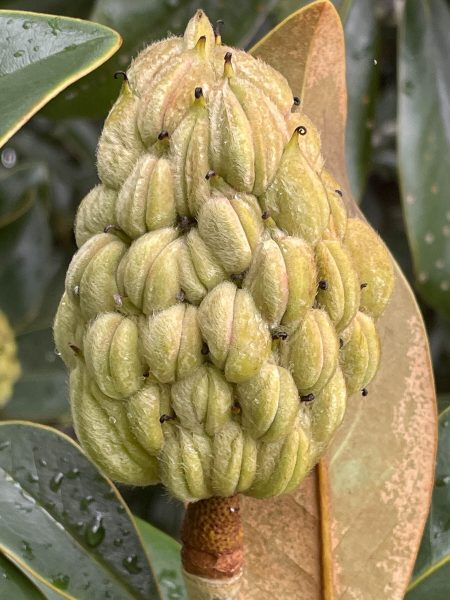Southern Magnolia
Magnolia grandiflora
The southern magnolia is known for its dense green foliage and large fragrant white flowers.
This section shows one large critter image at a time. Use the thumbnails that follow to select a specific image to display here.

This gallery contains a grid of small thumbnails. Selecting a thumbnail will change the main image in the preceding section.
Appearance
The southern magnolia tree has dense dark green foliage with large white flowers. The leaves are thick and glossy green with a rusty color and fuzzy underside. It has a straight trunk and conical crown.
Predators
Magnolia scale is an infection that can kill branches and trees. Tulip tree aphids, striped mealybugs, leaf weevils, magnolia leafminers and spider mites will feed on the tree. Mammals including squirrels, rabbits and opossums will eat the fruit. The fruit is also consumed by a wide variety of birds including wild turkeys, cedar waxwings, mockingbirds, orioles, northern cardinals, titmice, thrushes, warblers, finches, trashers, chickadees, grosbeaks, crows, jays, sparrows, nuthatches, vireos, hummingbirds, quail, woodpeckers and wrens.
Reproduction and life cycle
Flowers develop from late spring to early summer and cone-shaped fruits develop in the fall. When the seeds mature, they hang from the cone on thin strings. The seeds have a red fruit-like coating with a hard inner seed. Trees can start producing seeds at 10 years old but optimum production starts at 25 years old.
Did you know?
- Southern magnolias are fast-growing trees that can be excellent for landscape planting. Even though they are native to the south, they can reliably overwinter as far north as zone 6 of the USDA’s Plant Hardiness Zone Map.
- The tree is named after Pierre Magnol, a French botanist who brought the tree back to Europe 300 years ago.
Sources and additional information
- Lady Bird Johnson Wildflower Center - Southern Magnolia
- Arbor Day Foundation - Southern Magnolia
- USDA Forest Service Southern Research Station - Southern Magnolia
